The Louis Vuitton brand has survived over the years, has strengthened and has become today leader in the luxury luggage market. Today, we are dedicating a heading to its leaders who, thanks to their genius, have been able to transform and adapt the brand to the zeitgeist.
.
CHAPTER 1: LOUIS VUITTON, PORTRAIT OF A TALENTED CRAFTSMAN
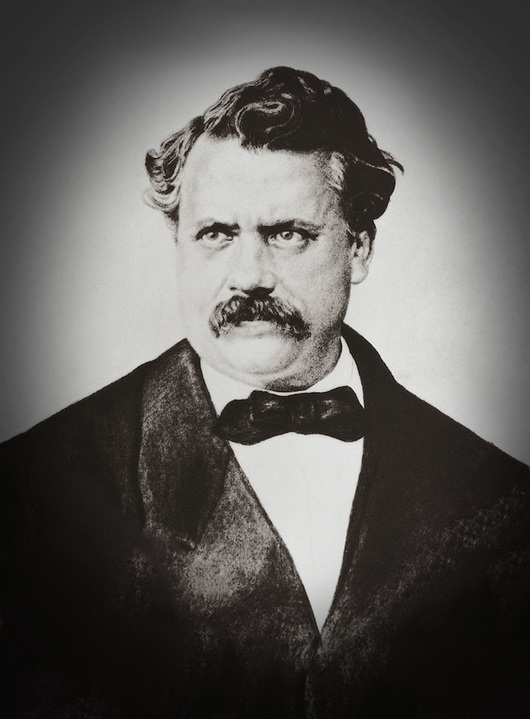 Photo: Louis Vuitton
Photo: Louis Vuitton
Everyone has already heard the name "Louis Vuitton". Everyone knows what their LV monogrammed brown canvas looks like, which has become so famous that it is also the most counterfeited in the world. But who is Louis Vuitton, founder of the brand? Today we confide you the portrait of a man who started from scratch and went down in history.
Born on August 4th, 1821, at the water mill of Chabouilla, near Anchay, in Jura, Louis Vuitton lived in a family more than modest. His father, a miller and a joiner, soon taught him how to handle tools and to work with wood. At the age of 16, he decides to leave the family home in order to try his luck in Paris and walks the 400 kilometres that separate him from the capital. Old enough to be an apprentice, and knowing how to handle woodworking tools, he joins the workshop of Mr. Maréchal, a box-maker, packer and trunk-maker (a job that consisted of packing the many belongings of wealthy travellers) and makes trunks for travelling.
Louis Vuitton distinguishes himself by his sense of aesthetics, his delicate and well-done work as well as his discretion. More and more customers of Mr. Maréchal are insistent that it should be the Jurassien who takes care of packing their belongings. Moreover, he becomes Empress Eugenie’s favourite packer in 1852. The revolution in the means of transport, with steam trains and automobiles, enables international tourism to develop. Travelling becomes more and more accessible. Louis Vuitton has then a revelation: rather than create a specific packaging for each object, why not make a line of innovative and functional luxury luggage? He creates then his first "Louis Vuitton" boutique in 1854, at 4 Neuve-des-Capucines street in Paris, as well as a line of high-quality trunks, and begins to stand out with his trianon grey canvas.
Louis Vuitton is an ambitious man. He really wants the brand that bears his name to be recognized as the best on the market, not only in France, but also abroad. He decides then in 1859 to develop and transfers his firm to Asnières, along the Seine in order to take advantage of the inland waterway transport.
The Louis Vuitton brand begins to expand abroad in 1885, with the help of Georges, Louis’s son. The first boutique outside France is situated in Oxford Street in London, and despite some difficult beginnings, it develops with great success. They will open subsequently other shops in New York and Philadelphia.
Louis Vuitton dies in 1892, leaving his son Georges a valuable inheritance, a rapidly expanding real empire. At the present time, the workshop in Asnières still exists and has 180 employees still working in leather goods. He started from scratch and has become one of the most famous names in the world; the talent of this legendary craftsman will be maintained from year to year by his heirs.
CHAPTER 2: GEORGES VUITTON, THE IRON-HANDED HEIR
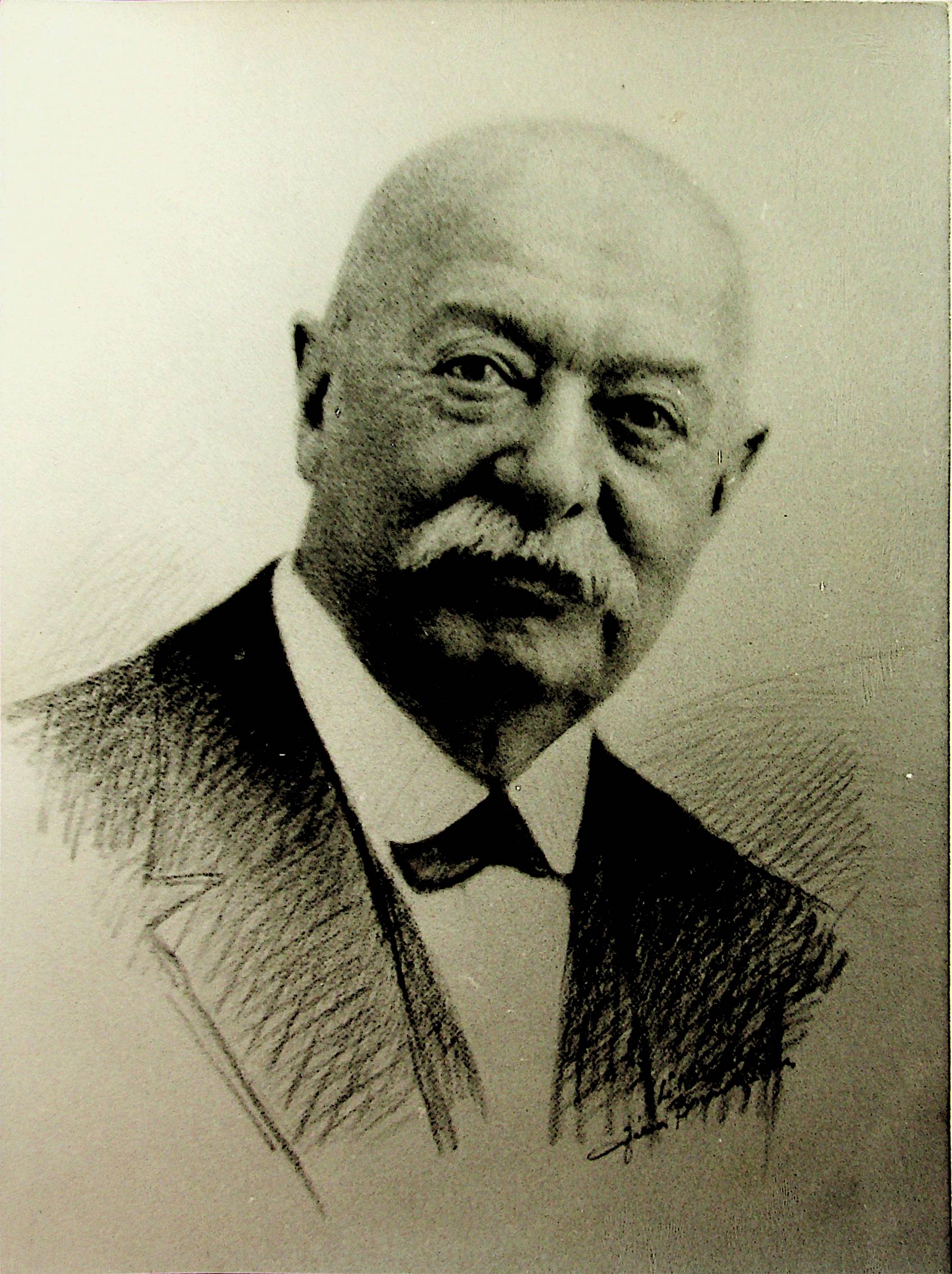 Portrait of Georges Vuitton.
Portrait of Georges Vuitton.
Born in 1857, Georges Vuitton, from childhood, walks around the corridors of the Asnières workshop. Like his father whom his employees used to call “Monsieur Louis”, Georges is called “Monsieur Georges” by the employees of the workshop. In 1872, Georges Vuitton is sixteen and he comes back from England, where he attended courses at St. Clement’s Eden House School. His father believes that two years of study are more than enough and that his son will be more helpful in the family run company in Paris. He will join once more the Asnières workshops on 2 January 1873 as an apprentice. He successively learns the trades of packer, joiner, seller, delivery man, cashing agent, he learns how to use the smoothing plane, the jack plane and the rasp.
Louis decides that it is time for Georges to take over the management of the Louis Vuitton boutique so that himself can concentrate on making new models. Georges is introduced to the suppliers, customers, business relations and will accompany his father during several months to all his business meetings. On 3 November 1880, Louis Vuitton takes the decision to make over his company to Georges and, at the same time, offers him a dowry for his marriage with the Patrelle heiress.
Very fond of England since his studies and wishing to conquer the English market, Georges Vuitton opens a first shop outside France in 1885, on Oxford Street in London. This aims not only to sell in England, but also to remind the French people tempted to buy English items that Louis Vuitton products are the best.
Louis Vuitton dies in 1892. His son Georges, helped by the whole family, succeeds him at the head of the empire, which he develops with the same success as the founder.
In 1896, four years after his father’s death, Georges decides to pay tribute to him and to thwart once for all those who copy their canvas by creating the Louis Vuitton monogrammed canvas. This is the first time a designer so much highlights his brand on a product. Years later this canvas will become the most counterfeited one in the world. He will also design a tamper-proof lock, challenged by Houdini, the key of which can open the trunks of a same series. Georges Vuitton will continue to lead the Louis Vuitton empire until his death in 1936.
Books : Le voyage : Des temps les plus reculés à nos jours.
CHAPTER 3: GASTON-LOUIS VUITTON, THE REFINED COLLECTOR
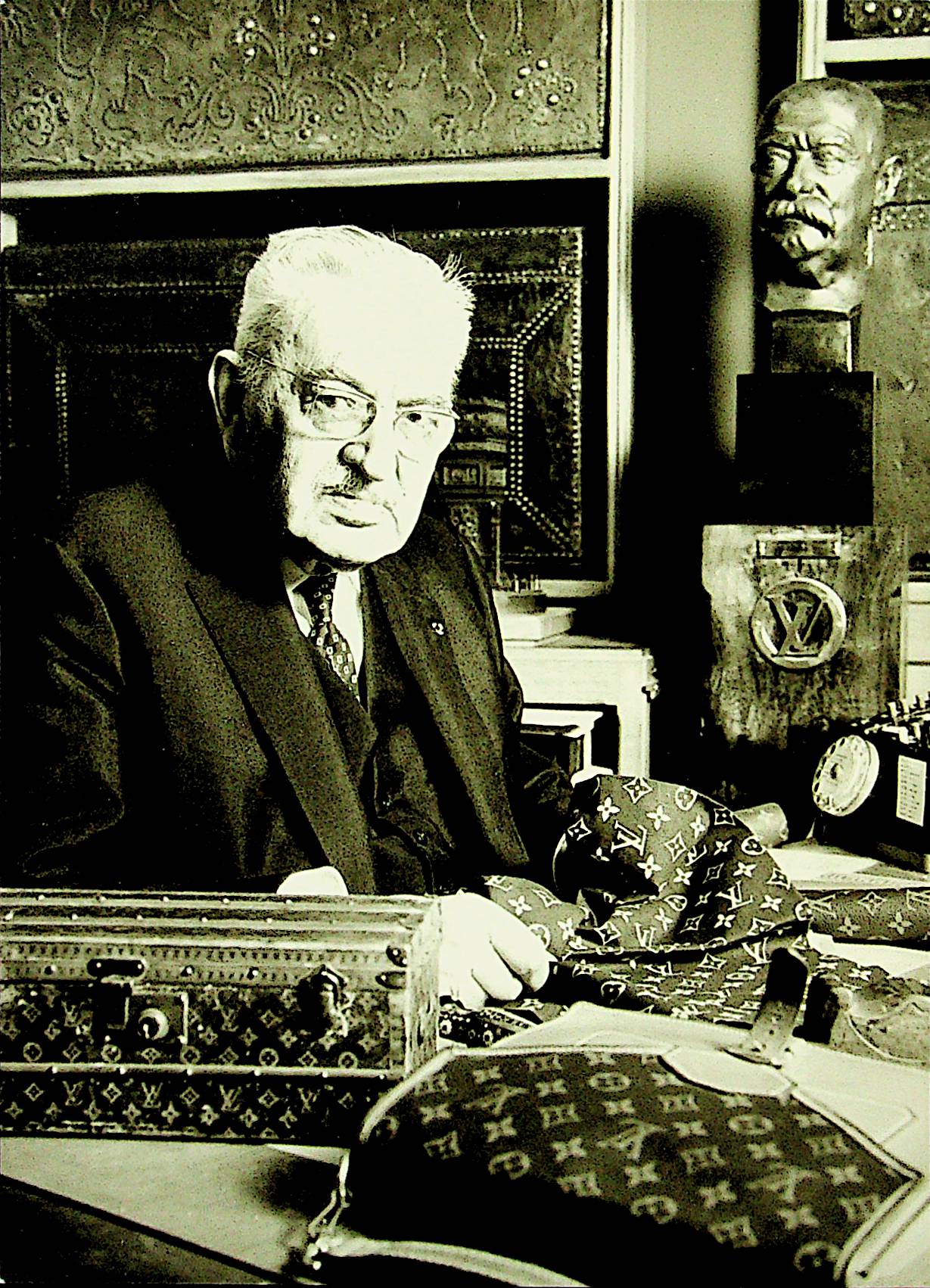 Gaston Louis Vuitton posing next to the famous flower trunk from the brand
Gaston Louis Vuitton posing next to the famous flower trunk from the brand
“I almost was born in a trunk!” states Gaston Louis Vuitton in the television program "Avis aux amateurs" in 1961.
Gaston Louis Vuitton was born on 30 January 1883. He is known for having a fragile health from childhood due to bronchitis problems. That is why he alternates school system and spa cures. He will write in a letter to General Henry Marti, "Having sit no exam, I have suffered no failure!". Because Gaston-Louis Vuitton was also a humorous man.
Gaston-Louis Vuitton gets married to his childhood friend on 15 November 1906, while he already has been an apprentice for eight-year at Louis Vuitton shop in Scribe Street. He takes part in the family business in 1907. In 1910, one of his younger brothers, Jean, dies.
Then the first world war breaks out. Because of his bronchial problems, he will be exempted from military service, while Pierre, Jean’s twin brother, is sent there. Gaston-Louis will get his assignment to the auxiliary service and will be mobilized on 1 February 1915. He will come back home on 10 March 1919. As for his brother Pierre, on 28 September 1917 he is declared “Mort pour la France” as a result of serious injuries. Of the five children of Georges and Josephine Vuitton, Gaston is the only one still alive after the war. The family will grow with his 7 children, including Thérèse who will die before being 4.
Unlike Louis and Georges Vuitton, Gaston and the twin brothers do not aspire only to trunk-maker and packer trades. Pierre and Jean build light cars, aeroplanes and helicopters and Gaston is sensitive to reading, arts, gardening and photography. His artistic eye will enable him to create magnificent window displays for the Louis Vuitton boutiques. The Asnières workshops change purpose: from trunk-makers as were his father and grandfather, the company Louis Vuitton becomes "Manufacturer of trunks, leather goods, goldsmith products and travel items" in 1914. In the Louis Vuitton catalogues, luxury products multiply and, adorned with their most beautiful finery, become true works of art.
The Wall Street crash will cause many shops on the Champs-Elysees to close: even the company Vuitton will suffer. But Gaston persists and involves himself in order to maintain Louis Vuitton at the same rank and, despite the difficulties, does not take the easy way out and keeps his high luxury products. He has only just recovered from this financial crisis when, like his father and grandfather before him, Gaston must face war. Thirty-eight percent of the shops in the Champs-Elysees will close within thirty days after 3 September 1939. Some time later he will leave for the Nice boutique and let his son Henry-Louis take care of the shop in a Paris under the Vichy regime.
Gaston-Louis dies in 1970. He will remain known as "The collector of objects" and for his love of delicate art which he will inject not only in his life and hobbies, but also directly in the Louis Vuitton brand.
Books : La Chambre des Merveilles : Les collections de Gaston Louis Vuitton.
CHAPTER 4: HENRY-LOUIS VUITTON, THE UNSUNG ONE
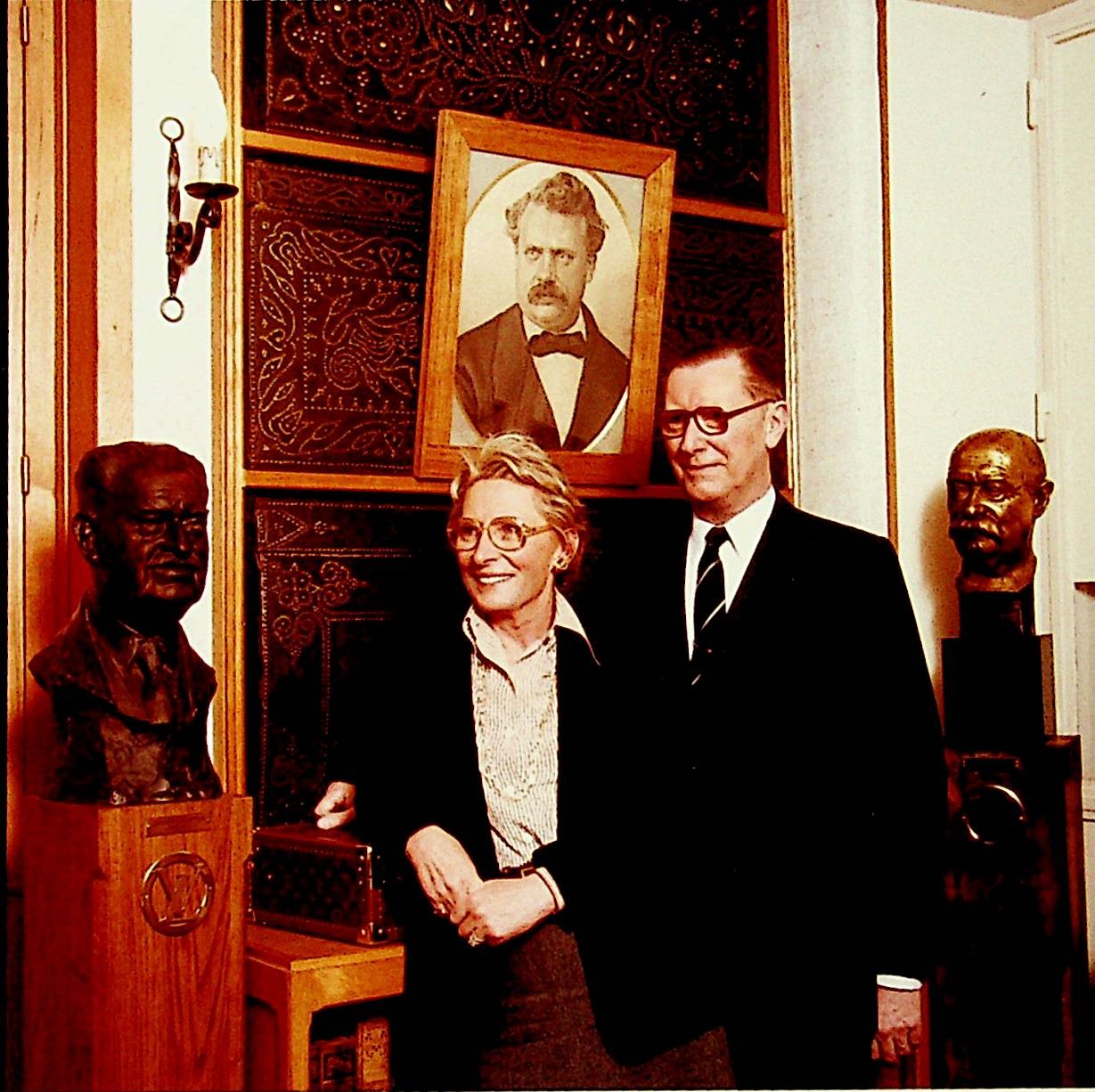 On the left : Odile Racamier, on the right Henry Louis Vuitton.
On the left : Odile Racamier, on the right Henry Louis Vuitton.
Busts : on the left, Gaston Louis Vuitton, on the right Georges Vuitton
Portrait in the middle : Louis Vuitton.
Henry-Louis Vuitton was born on 10 August 1911 in Asnières and died on 30 August 2002.
He is the son of Gaston-Louis Vuitton and Renée Versille.
He married Miss Josette Rateau on 15 October 1938. They had 3 children: Colette, Philippe-Louis (deceased), Danièle.
After studying at Cours St. Louis, he begins an apprenticeship in October 1928 in the Asnières factory, under the authority of his grand-father Georges Vuitton. In January 1929, Georges, who must set off on a long round in the United States, decides to take with him his 18-year old grand-son Henry-Louis, to encourage his beginnings as an apprentice. This will be his first big trip.
After a two-year traineeship during which he worked in every workshop to learn the luggage-maker trade, he starts his sales career at the Champs-Elysées shop where, alongside his grand-father Gaston-Louis Vuitton, he climbs all the rungs and is appointed, as soon as 1930, Sales Manager. He will take on all the responsibilities relating to this position until 1945. From 1945 to 1975, he holds the position of Commercial Director for the whole Company.
In 1959, a new material which, under certain heat conditions, can be applied on a linen or a cotton canvas, is presented to Gaston-Louis Vuitton. The process is applied at once on the LV canvas which, thus treated, retains all its flexibility and resistance. Very soon Henry-Louis suggests to his father creating a line of soft luggage and a whole range of travel bags for ladies and of small leather goods. Henry-Louis spends long hours cooped up in his office to create from A to Z 25 to 30 new models a year. Some of them are still on sale today.
In 1969, he leaves for Japan with his wife to open the first Louis Vuitton branch office.
In 1975 he is appointed President of the Board of Managers alongside his brothers-in-law Henry Racamier and Jean Ogliastro and will continue to be so until 1977 when he decides to retire. From 1977, he acts as President of Louis Vuitton Supervisory Board.
Career
1963-1977: President of the “Chambre Syndicale Nationale des Fabricants d’Articles de Voyage »
1963-1977: Vice-President of the “Fédération Nationale de la Maroquinerie et Articles de Voyage »
From 1974 : Member of the « Conseil National du Cuir » Arbitration Chamber
From 1973 : Vice-President of the « Comité Intersyndical des Elections Consulaires ». Appointed President for 1983.
Books :
- La Malle aux Souvenirs en 1984.
Medals:
Officer of the National Order of Merit
Knight of the Order of the Black Star (Benin)
Knight of the Order of the Star of Anjouan
Awards:
1914–1918 Commemorative War Medal
Bronze Medal in Physical education
“Grande Médaille d’Or du Travail”
Vermeil Medal of the “Ville de Paris
CHAPTER 5: HENRY RACAMIER, THE ENLIGHTENED BUSINESSMAN
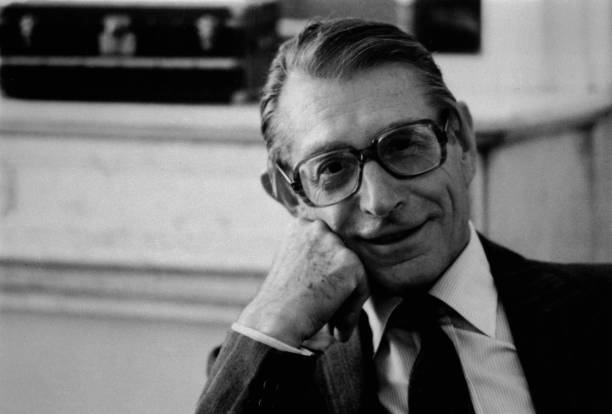 Henry Racamier.
Henry Racamier.
Born in 1912 in Pont-de-Roide, in Doubs, Henry Racamier first attended French business school "HEC" and then made his career in steel industry, logical choice when one knows that he is the son of an engineer. He begins his working career at Peugeot steelworks. Ten years later, at the end of the war, he starts his own business in special steels trading, Stinox. He successfully runs his business, travels the world to give it an international dimension and will remain its head for thirty years until 1977 when he sells it to Thyssen. He is then sixty-five.
The story could end there: he has made a success of his life and deserves a little rest. But at the age when others quietly withdraw, Henry Racamier emerges from the shadows. His wife, Odile Vuitton, one of Louis Vuitton's great-granddaughters, is a shareholder of the brand with her five cousins. At the time, Louis Vuitton employs 70 people and consists in only two stores. Its turnover hardly exceeds the equivalent of 10 million euros. Louis Vuitton, prestigious but modest SME, more and more often asks Henri Racamier for advice before entrusting him the management in 1977.
True trade genius, Henry Racamier starts from a simple observation: it is in the retail market that one earns the most money. He therefore opens a network of more than a hundred shops in ten years, particularly in Japan and the United States where the French luxury brand is much appreciated. In parallel the brand reworks its marketing, although it already has a very strong reputation, notably for being able to always meet its most difficult customers’ requirements. Henry Racamier makes the LV monogrammed canvas a world-renowned luxury emblem and endows Vuitton with a powerful image. 20 years later, Louis Vuitton posts a turnover of 690 million euros, i.e. sixty times more than on Henry Racamier’s arrival.
In June 1987, Louis Vuitton, leader of high-end luggage, merges with Moët-Hennessy, king of champagne and cognac. LVMH is born and becomes one of the stars of the Stock Exchange... Temporally. During the stock market crash of October 1987, LVMH weakens. A man has clearly got it: Bernard Arnault. This financier, who has already taken over Boussac and Dior, discreetly buys LVMH shares. When a few months later Henry Racamier seeks an ally to establish LVMH on the stock market again, Bernard Arnault seems to be the ideal candidate. Bernard Arnault, joined together with Guinness, will take control of LVMH, by joining forces alternately with the ones or the others and eventually will oust Chevalier, Moët-Hennessy's boss, and Racamier. In April 1990, Bernard Arnault is officially recognized as managing director of LVMH.
Henry Racamier will die on 29 March 2003.
CHAPTER 6: BERNARD ARNAULT, THE CURRENT MANAGER
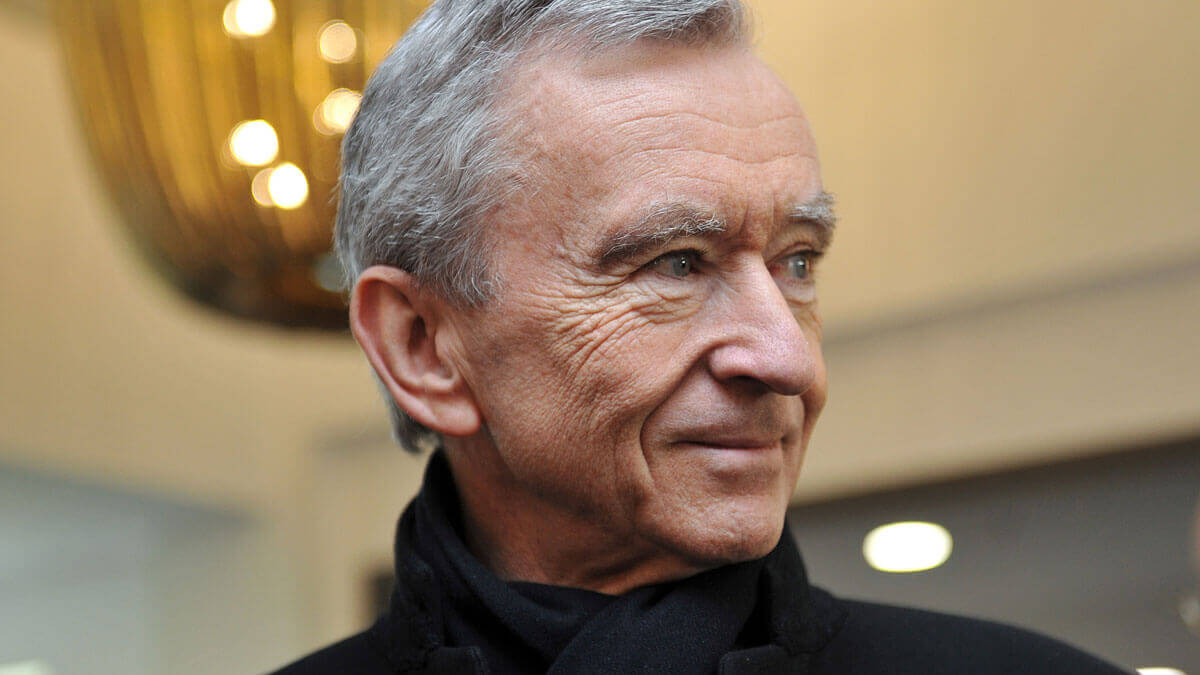 Bernard Arnault
Bernard Arnault
Bernard Arnault was born on 5 March 1949 in Roubaix. He is a French businessman, owner of LVMH luxury group, of Arnault group and of Christian Dior holding company. According to Forbes magazine 2018 ranking, he is the fourth richest person in the world and the first one in Europe.
Further to the October 1987 Krach, Bernard Arnault acquires LVMH shares, the recent luxury group resulting from the merger of two French groups on 3 June 1987, Moët Hennessy, a brand of Champagne and Cognac, and the Louis Vuitton group. The following year, in 1988, the group is looking for investors. Louis Vuitton CEO Henri Racamier and the shareholders ask Bernard Arnault to acquire a significant stake in the company. He becomes then one of the main shareholders.
At the same time, the management of the group faces difficulties: besides the disagreement between the families, the two co-chairmen stemming from the merger (Henri Racamier for Vuitton and Alain Chevalier for the wines and spirits) differ on the group strategic choices, thus paralysing the development of LVMH. Alain Chevalier wanted to resell wines and spirits activities to other groups, while Henri Racamier, become minority in the new group, wanted to regain Louis Vuitton's independence. In this environment, Bernard Arnault believes that the group must find a unique management and attempts to take the leadership of the group. He takes advantage of the dissenssions between the two men and asserts himself as the pivot shareholder for the future of the group by entering into successive alliances with both parties.
To take final control of the group, Bernard Arnault launches a takeover bid. Taking advantage of the stock market and shareholder mayhem, he becomes in July 1988 the main shareholder of LVMH. Bernard Arnault then ousts Alain Chevalier. On 13 January 1989, Bernard Arnault is unanimously elected Chairman of the Executive Management Board of LVMH. Henri Racamier strives by all means to cancel Bernard Arnault’s takeover bid, but on 16 May 1989, the court finds that no irregularity has been committed. The takeover bid is validated, and Bernard Arnault is confirmed at the head of the group. LVMH's financial structure makes him a general manager shareholder. He is General Manager of the group while being at the same time its controlling shareholder.
Since then, Bernard Arnault has led the company through an ambitious development plan, making LVMH the world's leading luxury group. In eleven years, the value of the group has multiplied by fifteen, while the turnover and profit have increased by 500%.
CHAPTER 7: YVES CARCELLE, THE DIVERSIFICATION MAN
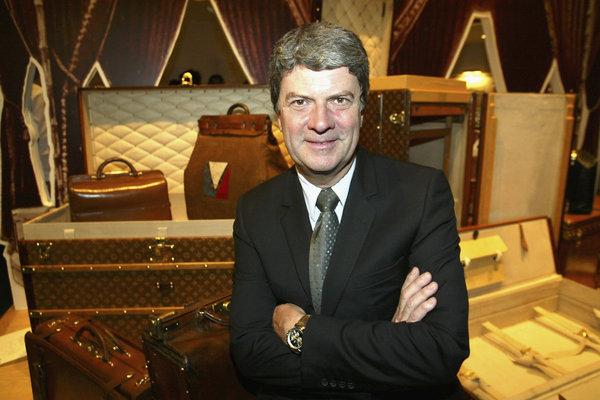 Yves Carcelle
Yves Carcelle
Yves Carcelle was born on 18 May 1948 in Paris. He graduated from both the École Polytechnique and INSEAD business school. By the end of the sixties, he turns towards marketing.
Yves Carcelle starts his career at Spontex and Absorbia. After managing Descamps from 1985 to 1989, he is offered by Bernard Arnault to join the LVMH group as Director of the Strategy, and in 1990 he becomes CEO of the subsidiary Louis Vuitton.
Under his management, the luggage-maker diversifies its ranges of leather goods, starts to create footwear and ready-to-wear, and welcomes Marc Jacobs. In 1999, Yves Carcelle takes the leadership of LVMH's Fashion and Leather Goods Group, which he leaves at the end of 2012 to become Vice-President of the Fondation Louis Vuitton.
His career pathways will be very positive: with the number of shops doubled, the turnover increased tenfold, the expansion to China and a presence in all the largest capitals of the world, as well as the development of the ready-to-wear range with Marc Jacobs, his twenty years of career will have left his mark on the brand history and will have made it the world’s first luxury goods brand.
He has died at the age of 66 on 31 August 2014 of kidney cancer.

